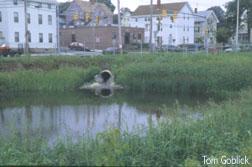Post Construction Runoff Control

Post-construction storm water management in areas undergoing new development or redevelopment is necessary because runoff from these areas has been shown to significantly effect receiving waterbodies. As runoff flows over areas altered by development, it picks up harmful sediment and chemicals such as oil and grease, pesticides, heavy metals, and nutrients. These pollutants often become suspended in runoff and are carried to receiving waters. Also of concern is that post construction runoff quantities may be increased, delivering more water to the waterbody during storms. Increased impervious surfaces interrupt the natural cycle of gradual percolation of water through vegetation and soil and can lead to streambank scouring and downstream flooding, which often lead to a loss of aquatic life and damage to property. Studies indicate that the most cost effective approach to storm water quality management is prior planning and design for the minimization of pollutants in post-construction storm water discharges.
To meet the requirements of this minimum control measure, the operator of a regulated small MS4 will need to at a minimum:
-
Develop and implement strategies which include a combination of structural and/or nonstructural BMPs;
- Develop an ordinance or other regulatory mechanism requiring the implementation of post-construction runoff controls to the extent allowable under State or local law;
- Ensure adequate long-term operation and maintenance of controls;
- Determine appropriate best management practices (BMPs) and measurable goals for this minimum control measure.
Recommendations for developing a successful post construction runoff control program:
- Select BMPs that are appropriate for the local community, minimize water quality impacts, and attempt to maintain predevelopment runoff conditions;
- Assess existing ordinances, policies, and programs that address storm water runoff quality; Participate in watershed planning efforts;
- Provide opportunities for public participation.
Additional Resources
